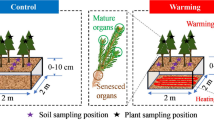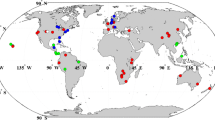Abstract
The present study aims in investigating the individual and combined effects of ozone (O3) exposure and nitrogen (N) load on the growth and photosynthetic characters of Cinnamomum camphora seedlings, a dominant evergreen broadleaf tree species in sub-tropical regions. The seedlings were supplied with N as NH4NO3 solution at 0, 30 and 60 kg ha−1 year−1 (simplified as N0, N30, N60, respectively) and were exposed to ambient O3 concentration (AA) or elevated [O3] (E-O3, AA +60 ppb) for one growth season. E-O3 induced significant negative effects on foliar photosynthesis, including lower photosynthetic rate, reduced carboxylation efficiency, quantum yield of PSII and photosynthetic pigment contents, despite no effect on growth. In contrast, N load acted as fertilization effects. Medium N (N30) increased photosynthetic pigments and stem-base diameter growth relative to N0, whereas high N load (N60) significantly enhanced the growth, photosynthetic pigments, and dark and light action of photosynthesis of C. camphora seedlings. No significant interactive effects of O3 and N load on the growth, net photosynthetic rate and pigment contents of the seedlings were found, suggesting that N supply to the soil at ≤60 kg ha−1 year−1 does not significantly change the sensitivity of C. camphora to ozone.
Similar content being viewed by others
References
Aber JD, Nadelhoffer KJ, Steudler P, Melillo JM (1989) Nitrogen saturation in northern forest ecosystems. Bioscience 39:378–386
Bassin S, Volk M, Fuhrer J (2007) Factors affecting the ozone sensitivity of temperate European grasslands: an overview. Environ Pollut 146:678–691
Bobbink R (1998) Impacts of tropospheric ozone and airborne nitrogenous pollutants on natural and semi-natural ecosystems: a commentary. New Phytol 139:161–168
Bortier K, De Temmerman L, Ceulemans R (2000) Effects of ozone exposure in open-top chambers on poplar (Populus nigra) and beech (Fagus sylvatica): a comparison. Environ Pollut 109:509–516
Boxman AW, van der Ven PJM, Roelofs JGM (1998) Ecosystem recovery after a decrease in nitrogen input to a Scots pine stand at Ijsselsteyn, The Netherlands. For Ecol Manage 101:155–163
Bytnerowicz A, Godzik B, Grodzińska K, Fraczek W, Musselman R, Manning W, Badea O, Popescu F, Fleischer P (2004) Ambient ozone in forests of the Central and Eastern European mountains. Environ Pollut 130:5–16
Calatayud V, Cervero J, Calvo E, Garcia-Breijo F-J, Reig-Arminana J, Sanz MJ (2011) Responses of evergreen and deciduous Quercus species to enhanced ozone levels. Environ Pollut 159:55–63
Chappelka AH, Samuelson LJ (1998) Ambient ozone effects on forest trees of the Eastern United States: a review. New Phytol 139:91–108
Coleman MD, Dickson RE, Isebrands JG (1998) Growth and physiology of aspen supplied with different fertilizer addition rates. Physiol Plant 103:513–526
De Vries W, Solberg S, Dobbertin M et al (2009) The impact of nitrogen deposition on carbon sequestration by European forests and heathlands. For Ecol Manage 258:1814–1823
Fares S, Goldstein A, Loreto F (2009) Determinants of ozone fluxes and metrics for ozone risk assessment in plants. J Exp Bot 61:629–633
Feng ZZ, Zeng HQ, Wang XK, Zheng QW, Feng ZW (2008) Sensitivity of Metasequoia glyptostroboides to ozone stress. Photosynthetica 46:463–465
Handley T, Grulke NE (2008) Interactive effects of O3 exposure on California black oak (Quercus kelloggii Newb.) seedlings with and without N amendment. Environ Pollut 156:53–60
Heath RL, Taylor GE (1997) Physiological processes and plant responses to ozone exposure. In: Sandermann H, Wellburn AR, Heath RL (eds) Forest decline and ozone. Springer, Berlin, pp 317–336
Holland EA, Braswell BH, Lamarque JF et al (1997) Variations in the predicted spatial distribution of atmospheric nitrogen deposition and their impact on carbon uptake by terrestrial ecosystems. J Geophys Res 102(D13):15849–15866
Ibrahim L, Proe MF, Cameron AD (1997) Main effects of nitrogen supply and drought stress upon whole-plant carbon allocation in poplar. Can J For Res 27:1413–1419
Izuta T, Nakaji T (2003) Effects of high nitrogen load and ozone on forest tree species. Eurasian J For Res 6:155–170
Kainulainen P, Holopainen JK, Holopainen T (2000) Combined effects of ozone and nitrogen on secondary compounds, amino acids, and aphid performance in Scots Pine. J Environ Qual 29:334–342
Karnosky DF, Skelly JM, Percy KE, Chappelka AH (2007) Perspectives regarding 50 years of research on effects of tropospheric ozone air pollution on US forests. Environ Pollut 147:489–506
Lichtenthaler HK (1987) Chlorophylls and carotenoids: pigments of photosynthetic biomemberance. Method Enzymol 148:350–382
Lippert M, Häberle KH, Steiner K, Payer HD, Rehfuess KE (1996) Interactive effects of elevated CO2 and O3 on photosynthesis and biomass production of clonal 5-year-old Norway spruce (Picea abies (L.) Karst.) under different nitrogen nutrition and irrigation treatments. Trees 10:382–392
Long SP, Bernacchi CJ (2003) Gas exchange measurements, what can they tell us about the underlying limitations to photosynthesis? Procedures and sources of error. J Exp Bot 54:2393–2401
Lu CQ, Tian HQ (2007) Spatial and temporal patterns of nitrogen deposition in China: synthesis of observational data. J Geophys Res 112:D22S05
Nali C, Paoletti E, Marabottini R et al (2004) Ecophysiological and biochemical strategies of response to ozone in Mediterranean evergreen broadleaf species. Atmos Environ 38:2247–2257
Nihlgard B (1985) The ammonium hypothesis: an additional explanation to the forest dieback in Europe. Ambio 14:2–8
Novak K, Schaub M, Fuhrer J, Skelly JM, Hug C, Landolt W, Bleuler P, Krauchi N (2005) Seasonal trends in reduced leaf gas exchange and ozone-induced foliar injury in three ozone sensitive woody plant species. Environ Pollut 136:33–45
Paoletti E (2006) Impact of ozone on Mediterranean forests: a review. Environ Pollut 144:463–474
Pell EJ, Sinn PJ, Johansen CV (1995) Nitrogen supply as a limiting factor determining the sensitivity of Populus tremuloides Michx. to ozone stress. New Phytol 130:437–446
Reich PB (1987) Quantifying plant response to ozone: a unifying theory. Tree Physiol 3:63–91
Schulze ED, De Vries W, Hauhs M et al (1989) Critical loads for nitrogen deposition on forest ecosystems. Water Air Soil Pollut 48:451–456
The Royal Society (2008) Ground-level ozone in the 21st century: future trends, impacts and policy implications. Science Policy Report 15/08. The Royal Society, London
Thomas VFD, Braun S, Fluckiger W (2005) Effects of simultaneous ozone exposure and nitrogen loads on carbohydrate concentrations, biomass, and growth of young spruce trees (Picea abies). Environ Pollut 137:507–516
Thomas VFD, Braun S, Fluckiger W (2006) Effects of simultaneous ozone exposure and nitrogen loads on carbohydrate concentrations, biomass, growth, and nutrient concentrations of young beech trees (Fagus sylvatica). Environ Pollut 143:341–354
Townsend AR, Braswell BH, Holland EA, Penner JE (1996) Spatial and temporal patterns in terrestrial carbon storage due to deposition of fossil fuel nitrogen. Ecol Appl 6:806–814
Utriainen J, Holopainen T (2001) Nitrogen availability modifies the ozone responses of Scots pine seedlings exposed in an open-field system. Tree Physiol 21:1205–1213
Wang XK, Mu YJ, Ouyang ZY et al (2002) Study on emission of isoprene from major plants living in Taihu Basin. Chin Bull Bot 19:224–230
Wang HX, Zhou LJ, Tang XY (2006) Ozone concentrations in rural regions of the Yangtze Delta in China. J Atmos Chem 54:255–265
Wang XH, Kent M, Fang XF (2007) Evergreen broad-leaved forest in Eastern China: its ecology and conservation and the importance of resprouting in forest restoration. For Ecol Manage 245:76–87
Watanabe M, Yamaguchi M, Tabe C et al (2007) Influences of nitrogen load on the growth and photosynthetic responses of Quercus serrata seedling to O3. Trees 21:421–432
Watanabe M, Yamaguchi M, Matsumura H, Kohno Y, Izuta T (2008) Effects of ozone on the growth and photosynthesis of Castanopsis sieboldii seedlings grown under different nitrogen loads. J Agric Meteorol 64:143–155
Wittig VE, Ainsworth EA, Long SP (2007) To what extent do current and projected increases in surface ozone affect photosynthesis and stomatal conductance of trees? A meta-analytic review of the last 3 decades of experiments. Plant Cell Environ 30:1150–1162
Wittig VE, Ainsworth EA, Naidu SL, Karnosky DF, Long SP (2009) Quantifying the impact of current and future tropospheric ozone on tree biomass, growth, physiology and biochemistry: a quantitative meta-analysis. Global Change Biol 15:396–424
Yamaguchi M, Watanabe M, Iwasaki M et al (2007) Growth and photosynthetic responses of Fagus crenata seedlings to O3 under different nitrogen loads. Trees 21:707–718
Acknowledgments
This study was supported by the National Natural Science Foundation of China (No. 30700086) and Tiantong National Station of Forest Ecosystems (XT200707). The authors thank Professor Zongwei Feng and Dr. Hua Zheng for their valuable suggestions on this experiment. The critical comments of two anonymous reviewers are also appreciated.
Author information
Authors and Affiliations
Corresponding authors
Additional information
Communicated by T. Grams.
Rights and permissions
About this article
Cite this article
Feng, Z., Niu, J., Zhang, W. et al. Effects of ozone exposure on sub-tropical evergreen Cinnamomum camphora seedlings grown in different nitrogen loads. Trees 25, 617–625 (2011). https://doi.org/10.1007/s00468-011-0538-x
Received:
Revised:
Accepted:
Published:
Issue Date:
DOI: https://doi.org/10.1007/s00468-011-0538-x




